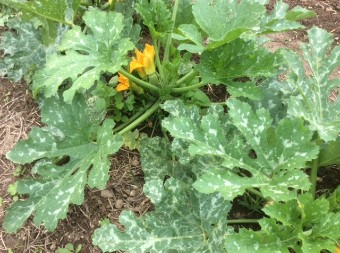
Early in June mulch tomatoes, peppers, okra, squash, cucumbers and asparagus if it hasn’t already been done. Weed or scuffle hoe before mulching. Water as necessary to make sure your crops are getting about 1 inch of water a week from rain, drip irrigation or your hose.
Continue to sow  weekly successions of beans, corn, cucumbers, and summer squash. Begin sowing very heat resistant lettuces like Jericho, Anuenue, Sierra, and Slo-bolt every 7 days under shade cloth or plastic screen. Transplant to a spot with afternoon shade on an overcast day.
Harvest onions on a dry day after half the tops have fallen over. For better storage harvest garlic when the 6th leaf down or 50% of the leaves on your plants are brown (the remaining green leaves will dry down to form the wrapper layers during curing). Hang onions and garlic to air cure for 2 weeks before storing. Transplant leeks from flats or seedling beds to their permanent place in the garden.
Finish planting and hill up peanuts at 12″ tall and mulch before they peg. Unlike most other plants, the peanut plant flowers above ground but the fruits, the peanuts are sent down on a stem for the embryo to form in the ground. The stem is what we call a peg, so the process is called pegging.
Hand pick Colorado Potato Beetles as soon as the first larvae are spotted on early potatoes and again every 5-7 days. Mid June plant and immediately mulch late planted potatoes for Fall harvest while your onions and garlic are curing.
In the last week of June start sowing Brassicas for Fall (brussel sprouts, brocccoli, cauliflower, cabbage, savoys) 2 or 3 sowings a week apart under proteknet or spun polyester row cover. If you have time continue to weed and mulch any crops that need some more.
Harvest early and often to get the best production from your hot weather garden.









